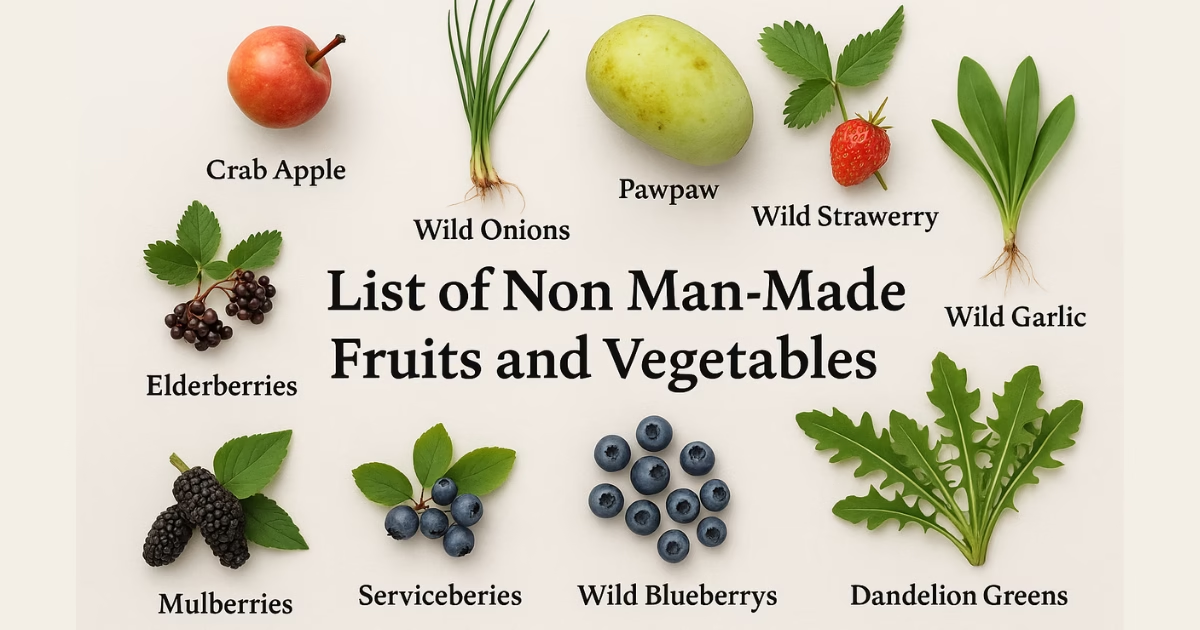When it comes to the food we eat today, most fruits and vegetables have been shaped by human hands over thousands of years. Through selective breeding, hybridization, and farming, many plants have been made sweeter, bigger, or easier to grow. However, some plants have managed to stay close to their original, natural form. These are known as non man-made fruits and vegetables. They have existed in the wild without much or any human interference. Eating them connects people to the ancient roots of nature’s purest foods. In this blog post, we will explore a complete list of non man-made fruits and vegetables that still exist today. From tiny wild berries to hearty green plants growing freely, these foods offer a glimpse into the past and a taste of what the earth once naturally provided without farming techniques or genetic modifications.
Complete List of Non Man-Made Fruits and Vegetables
When searching for truly natural foods, it is important to understand which fruits and vegetables have remained mostly untouched by human cultivation. Below is a complete list of non man-made fruits and vegetables that continue to grow in the wild today. These plants have adapted naturally to their environments and have survived without human help or selective breeding. Some of them are harder to find because modern agriculture has replaced many wild varieties, but they still thrive in forests, fields, and untouched landscapes.
In this list, you will discover fruits and vegetables that carry the original traits nature gave them — small sizes, strong flavors, and tough survival skills. Their appearance, taste, and even their growing habits are very different compared to the polished produce seen at the supermarket. Let us dive into these fascinating examples of real, natural foods that have stood the test of time.
Non Man-Made Fruits You Can Still Find Today
Some fruits have stayed almost the same for thousands of years. They grow naturally without any help from farmers or scientists. These non man-made fruits offer strong flavors and a direct connection to wild nature. Here are some examples you can still find today:
Wild Blueberries
Wild blueberries are smaller and more flavorful than farmed ones. They grow naturally in forests, especially in North America. Their rich taste and high antioxidants make them special.
Wild Strawberries
Unlike the large, sweet strawberries sold in stores, wild strawberries are tiny but packed with flavor. They have been growing naturally for centuries in Europe, Asia, and North America.
Crabapples
Crabapples are the wild ancestors of today’s apples. They are smaller and much more tart, often growing along roadsides or in untended fields.
Pawpaw Fruit
Native to the eastern United States, pawpaw fruits are creamy and tropical-tasting. They have not been heavily farmed or altered, staying close to their wild form.
Mulberries
Mulberry trees often grow wild and produce sweet berries. Black, white, and red mulberries can all be found in different regions without farming.
Elderberries
Elderberries are small, dark berries growing naturally in many parts of the world. People have used them for food and medicine for centuries.
Huckleberries
Closely related to blueberries, huckleberries grow wild in mountainous areas. They are a favorite for foragers due to their strong, sweet flavor.
Currants
Wild currants thrive in cooler climates. They are tart and nutritious, often found in forests or abandoned fields.
Serviceberries (Saskatoon berries)
These sweet, blueberry-like fruits grow wild across North America. They have been eaten by native peoples long before modern farming.
Each of these fruits shows what nature can create without human changes. Their flavors are often stronger, and their nutrients can be even higher than those of farmed varieties.
Non Man-Made Vegetables and Edible Greens
Wild vegetables and greens have survived without farming too. Many are common plants, often seen as weeds today, but they offer valuable nutrition. Here are some examples:
Wild Onions
Wild onions grow naturally in fields and forests. They are smaller than store onions but have a sharp, rich flavor.
Wild Garlic
Found in shady woods, wild garlic has strong-smelling leaves and bulbs. It is often foraged in the spring.
Watercress
Growing naturally in clean, flowing water, watercress is a peppery green full of vitamins. It was eaten long before modern farming.
Dandelion Greens
Most people see dandelions as weeds, but the leaves are edible. Dandelion greens have been a wild food for centuries.
Purslane
Purslane is a succulent plant that grows naturally in many parts of the world. It is rich in omega-3 fatty acids.
Lamb’s Quarters
Also known as wild spinach, lamb’s quarters are a wild leafy green packed with nutrients. They were once a staple food.
Nettle (Stinging Nettle)
Despite their sting, cooked nettles are a nutritious food. They grow wild in moist, rich soils.
Fiddleheads
Fiddleheads are the young shoots of certain ferns. They are foraged in the wild in early spring and are rich in fiber and antioxidants.
Wild Asparagus
Unlike farmed asparagus, wild asparagus is thinner and can often be found growing freely along roadsides and fields.
These vegetables remind people that many common plants were food sources long before agriculture became organized.
How Fruits and Vegetables Became Man-Made
Thousands of years ago, humans began to change plants to better suit their needs. They picked the biggest, sweetest, or prettiest fruits and saved seeds from those. Over generations, this selective breeding created the fruits and vegetables seen today.
Bananas are a good example. Wild bananas had large seeds and little flesh. Over time, people selected plants with more edible parts and fewer seeds. Now, farmed bananas look and taste nothing like their wild ancestors.
Corn, or maize, started as a simple grass called teosinte. It had tiny ears and hard seeds. Through careful growing and selection, ancient people in Mexico transformed it into the large, sweet corn we know today.
Even watermelons used to be different. Early versions were small and bitter, not the sweet, juicy fruits found now. Changes like these show how farming has reshaped natural foods over time.
Why Non Man-Made Fruits and Vegetables Are Rare Today
Modern farming focuses on crops that are easy to grow, ship, and sell. This means wild foods have been pushed aside. People prefer bigger, sweeter, and longer-lasting fruits and vegetables. Farming also created plants that could survive diseases, pests, and bad weather.
At the same time, wild habitats have shrunk. Forests and fields were cleared for cities, roads, and farms. Many natural food sources disappeared.
Genetic modification has also played a part. Some crops have been altered at the DNA level to improve their resistance or yield. These changes further distance them from their wild ancestors.
Because of all these reasons, it is rare to find fruits and vegetables today that have not been shaped in some way by humans. Wild foods survive mostly in untouched areas, where nature still controls the growth.
Health Benefits of Eating Wild and Natural Plants
Wild fruits and vegetables often have more nutrients than their farmed cousins. They tend to be higher in fiber, antioxidants, and important vitamins. Their strong flavors often mean stronger health benefits too.
Since they grow without chemicals, wild plants are usually free from pesticides and synthetic fertilizers. This can make them a healthier choice for people seeking natural diets.
Eating wild foods can also help connect people to the environment. It encourages better understanding of nature, seasons, and sustainable living.
However, it is important to be careful. Not every wild plant is safe to eat. Foraging requires knowledge and respect for nature to avoid dangerous mistakes.
Tips to Find and Identify Non Man-Made Fruits and Vegetables
For those interested in experiencing true wild foods, here are some basic tips:
- Learn about local plants
Books, online guides, and local classes can help identify edible wild plants. - Start with common wild foods
Dandelions, wild onions, and blackberries are good places to start. - Visit farmers’ markets
Some markets offer wild-harvested foods from local growers. - Be cautious
If you are unsure about a plant, do not eat it. Some wild plants look alike but are poisonous. - Respect the environment
Only take what you need and avoid damaging plants or ecosystems.
Finding and eating wild foods can be rewarding, but it should always be done responsibly.
Also Read: Anchovies in Ketchup: The Weird Combo You’ll Want to Try
Final Thoughts on the List of Non Man-Made Fruits and Vegetables
In a world filled with modified and farmed foods, discovering the original creations of nature can be an exciting journey. This complete list of non man-made fruits and vegetables shows how nature provided nutritious, delicious foods long before modern farming practices.
Although many wild foods are harder to find today, they still exist for those willing to look. Whether for health reasons, curiosity, or a desire to connect with the past, exploring these natural foods offers a rich experience.
By understanding and appreciating non man-made plants, people can reconnect with the earth and remember that the best things sometimes come straight from nature, without any human touch.

Hi, I’m Shafy Ali – a curious mind and passionate writer at Celiac Magazine. I cover a little bit of everything, from everyday tips and how-tos to deeper dives into topics that spark conversation. I enjoy turning research into readable, relatable content that informs and inspires. Whatever the subject, I aim to keep it clear, engaging, and genuinely useful.

